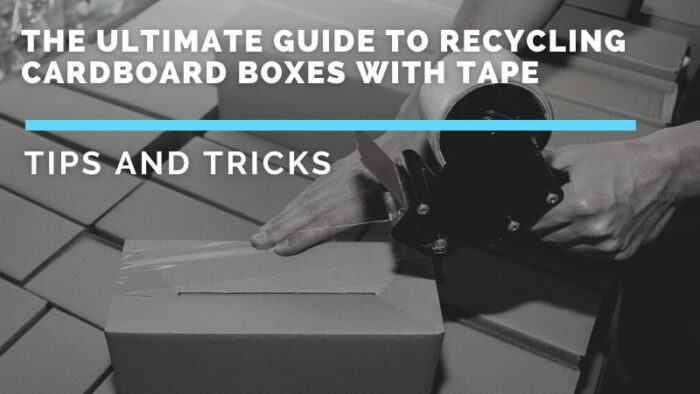Yes, you can recycle cardboard boxes with tape on them. The tape does not need to be removed before recycling the box.
However, removing non-paper materials, such as plastic or bubble wrap, is generally a good idea from the box before recycling. This helps to keep the recycling stream clean and makes it easier for the recycling facility to process the material. Additionally, it is a good idea to flatten the boxes before recycling them to save space in the recycling bin and make them easier to transport.
How to Remove Tape from Cardboard Boxes for Recycling
You can use several methods to remove the tape from cardboard boxes for recycling. Here are a few options to consider:
- Use a knife or scissors to carefully cut the tape away from the cardboard. This works best if the tape is still relatively fresh and has not been stuck to the cardboard for an extended period.
- Use a hair dryer to heat the tape. This will cause the tape to become more pliable, making it easier to remove.
- Use a solvent such as rubbing alcohol or mineral spirits to dissolve the tape. This can be effective, but be sure to use caution and follow the safety instructions on the solvent packaging.
- If the tape is particularly stubborn, you may need to use a combination of these methods. For example, you could use a hair dryer to loosen the tape and then use a knife or scissors to cut it away carefully.
It is essential to remove as much tape as possible from cardboard boxes before recycling them, as the tape can interfere with the recycling process and make it more difficult to repurpose the cardboard. However, recycling the box with the attached tape is okay if the tape is stuck to the cardboard and cannot be removed.
What Happens if Tape Remains on the Cardboard?
If tape remains on the cardboard when recycled, it will typically go through the recycling process along with the rest of the material. The recycling facility will use a combination of machines and manual labor to sort the materials into different categories, such as paper, plastic, and metal. The tape may be removed during this process or remain on the cardboard.
In general, removing the tape from cardboard is unnecessary before recycling it. However, if the tape is filthy or there is a large amount of it on the cardboard, it could cause issues during the recycling process. For example, if the tape is very sticky, it could cause problems with the machinery at the recycling facility. In cases like this, it may be a good idea to remove the tape before recycling the cardboard to help ensure that the material is processed correctly.

Other Things That Can Contaminate Cardboard
Several things can contaminate cardboard and limit its recyclability. Some common contaminants include:
- Food and liquid residues: Cardboard that has come into contact with food or liquid can be difficult to recycle. The moisture from the food or liquid can weaken the cardboard, and the presence of organic material can cause odors and attract pests.
- Non-paper materials: Cardboard contaminated with non-paper materials, such as plastic wrap or bubble wrap, cannot be recycled. It is essential to remove these materials before recycling the cardboard.
- Grease and oil: Cardboard contaminated with grease or oil is not recyclable. The grease or oil can weaken the cardboard and make it difficult to process.
- Sharp objects: Cardboard punctured or cut by sharp objects, such as nails or staples, cannot be recycled. These objects can damage the machinery at the recycling facility.
- Non-cardboard materials: Cardboard contaminated with non-cardboard materials, such as metal or plastic, cannot be recycled. It is essential to separate these materials before recycling the cardboard.
Overall, keeping cardboard clean and free of contaminants is essential to ensure it can be recycled. Flattening the boxes before recycling them can also help reduce the material volume and make it easier to transport.
Conclusion
Cardboard boxes with tape on them can be recycled. The tape does not need to be removed before recycling the box but removing any non-paper materials, such as a plastic wrap or bubble wrap, is generally a good idea.
It is also a good idea to flatten the boxes before recycling them to save space in the recycling bin and make them easier to transport. Contaminants, such as food and liquid residues, non-paper materials, grease and oil, sharp objects, and non-cardboard materials, can limit the recyclability of cardboard.
Keeping cardboard clean and free of contaminants is essential to ensure it can be recycled.

